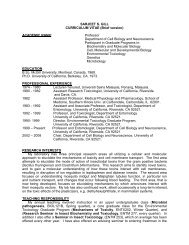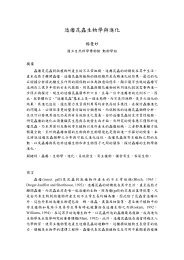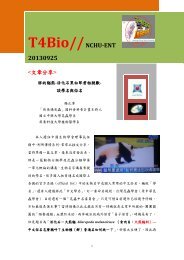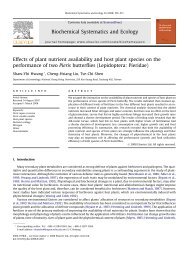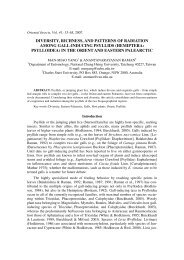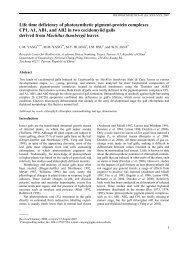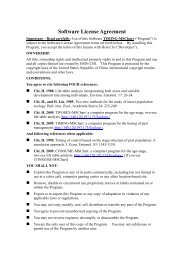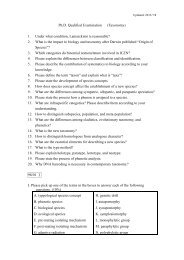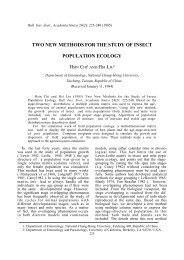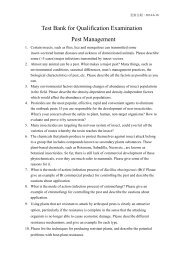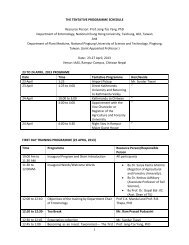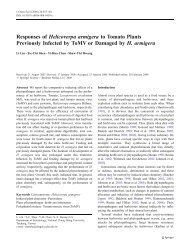Host range of Cybocephalus flavocapitis and Cybocephalus ...
Host range of Cybocephalus flavocapitis and Cybocephalus ...
Host range of Cybocephalus flavocapitis and Cybocephalus ...
You also want an ePaper? Increase the reach of your titles
YUMPU automatically turns print PDFs into web optimized ePapers that Google loves.
Journal <strong>of</strong> Asia-Pacific Entomology 15 (2012) 595–599<br />
Contents lists available at SciVerse ScienceDirect<br />
Journal <strong>of</strong> Asia-Pacific Entomology<br />
journal homepage: www.elsevier.com/locate/jape<br />
<strong>Host</strong> <strong>range</strong> <strong>of</strong> <strong>Cybocephalus</strong> <strong>flavocapitis</strong> <strong>and</strong> <strong>Cybocephalus</strong> nipponicus, two potential<br />
biological control agents for the cycad aulacaspis scale, Aulacaspis yasumatsui<br />
Sing-Ying Song, Ching-Wen Tan, Shaw-Yhi Hwang ⁎<br />
Department <strong>of</strong> Entomology, National Chung Hsing University, Taichung, Taiwan<br />
article<br />
info<br />
abstract<br />
Article history:<br />
Received 13 March 2012<br />
Revised 2 June 2012<br />
Accepted 4 June 2012<br />
Available online 11 June 2012<br />
Keywords:<br />
Aulacaspis yasumatsui<br />
<strong>Cybocephalus</strong> <strong>flavocapitis</strong><br />
<strong>Cybocephalus</strong> nipponicus<br />
<strong>Host</strong> scale <strong>range</strong><br />
<strong>Host</strong>-<strong>range</strong> <strong>and</strong> host-specificity tests were performed with <strong>Cybocephalus</strong> <strong>flavocapitis</strong> T. R. Smith (Coleoptera:<br />
Cybocephalidae) <strong>and</strong> <strong>Cybocephalus</strong> nipponicus Endrödy-Younga (Coleoptera: Cybocephalidae), two biological control<br />
c<strong>and</strong>idates against the invasive cycad aulacaspis scale, Aulacaspis yasumatsui Takagi (Hemiptera: Diaspididae).<br />
Seventeen native scale species plus the invasive A. yasumatsui scale were tested in growth chambers using nochoice<br />
tests <strong>and</strong> hosts suitable for each <strong>of</strong> the two predatory beetles. The results revealed that the two <strong>Cybocephalus</strong><br />
beetles, one imported species from Thail<strong>and</strong> <strong>and</strong> one native species, both fed on relatively similar scale prey species.<br />
Additionally, the adult beetles <strong>of</strong> these two species oviposited only on Diaspididae scales. The results showed<br />
that both <strong>Cybocephalus</strong> beetles may share a similar host niche in Taiwan.<br />
© Korean Society <strong>of</strong> Applied Entomology, Taiwan Entomological Society <strong>and</strong> Malaysian Plant Protection Society,<br />
2012. Published by Elsevier B.V. All rights reserved.<br />
Introduction<br />
The cycad aulacaspis scale (CAS), Aulacaspis yasumatsui Takagi<br />
(Hemiptera: Diaspididae), is an armored scale that originated in Thail<strong>and</strong><br />
(Takagi, 1977). As a result <strong>of</strong> human activity <strong>and</strong> worldwide trading <strong>of</strong><br />
cycads, this cycad scale has spread rapidly to many countries including<br />
China, Singapore, Hong Kong, Taiwan, Cayman Isl<strong>and</strong>s, Puerto Rico,<br />
Vieques Isl<strong>and</strong>, U.S. Virgin Isl<strong>and</strong>s, the Hawaiian isl<strong>and</strong>s, <strong>and</strong> Guam<br />
(The International Union for Conservation <strong>of</strong> Nature <strong>and</strong> Natural Resources/Species<br />
Survival Commission-IUCN/SSC, 2005; Germain <strong>and</strong><br />
Hodges, 2007). The CAS has recently become a major threat to many cultivated<br />
<strong>and</strong> native cycads, because it is multivoltine. The CAS has a relatively<br />
high reproductive potential <strong>and</strong> feeds on above <strong>and</strong> below ground<br />
cycad tissues (Howard et al., 1999; Bailey et al., 2010; Marler <strong>and</strong> Moore,<br />
2010).<br />
The CAS was first identified in Taoyuan county, Taiwan in 2000 (Chao<br />
<strong>and</strong> Lai, 2005) <strong>and</strong> has quickly spread to most <strong>of</strong> the isl<strong>and</strong>. Since then, the<br />
CAS has threatened cultivated cycads, such as Cycas revoluta Thunberg<br />
(Cycadales: Cycadaceae), in home gardens, commercial nurseries, <strong>and</strong><br />
local l<strong>and</strong>scapes in Taiwan. In addition, Cycas taitungensis, anendemic<br />
cycad species <strong>of</strong> Taiwan have also encountered the threat from this invasive<br />
pest (IUCN/SSC, 2005). Cy. taitungensis occurs mainly in forest<br />
reserves in the mountain area <strong>of</strong> Hongye, Taitung county, <strong>and</strong> its association<br />
with the CAS in these forest reserves has been monitored since 2004<br />
(Chao <strong>and</strong> Lai, 2005). The results <strong>of</strong> these monitoring projects have<br />
⁎ Corresponding author at: Department <strong>of</strong> Entomology, National Chung Hsing University,<br />
250 Kuo Kuang Road, Taichung, Taiwan 402, ROC. Tel.: +886 4 22840363; fax: +886 4<br />
22875024.<br />
E-mail address: ole<strong>and</strong>er@dragon.nchu.edu.tw (S-Y. Hwang).<br />
indicated that CAS infestations do occur, but that they are moderate in<br />
most Cy. taitungensis trees (Hwang, unpublished data). However, the<br />
CAS has destroyed <strong>and</strong> significantly affected the fitness <strong>of</strong> many Cy.<br />
taitungensis seedlings in these forest reserves.<br />
However, a promising control protocol for eradicating the CAS in<br />
cultivated or wild cycads is lacking. The IUCN has recommended several<br />
CAS control measures, such as insecticides, biological control, mechanical/cultural<br />
methods, as well as integrating these measures (IUCN/SSC,<br />
2005). Several insecticides have been tested on the CAS during cycad<br />
cultivation (Emshousen et al., 2004). However, the CAS are sheltered<br />
by a protective wax covering <strong>and</strong> tuck themselves into crevices <strong>of</strong> the<br />
host plant, making the aerosol insecticide application less effective<br />
(Marler <strong>and</strong> Moore, 2010). Systemic insecticides could be applied directly<br />
to the soil or leaves to control the CAS in small scale areas, such<br />
as cultivated gardens. However, the wild cycad Cy. taitungensis is<br />
scattered over a wide area <strong>and</strong> is distributed over remote mountain forest<br />
reserves in difficult terrain. As a result, applying pesticides in these<br />
forest reserves is very difficult <strong>and</strong> could have a serious adverse impact<br />
on other nontarget organisms.<br />
The IUCN has also proposed introduction <strong>of</strong> natural enemies as the<br />
most cost <strong>and</strong> labor-effective control method for CAS infestation (IUCN/<br />
SSC, 2005). Since 1998, the parasitic wasp, Coccobius fulvus (Compere<br />
<strong>and</strong> Annecke) (Hymenoptera: Aphelinidae), <strong>and</strong> the predatory beetle,<br />
<strong>Cybocephalus</strong> nipponicus Endrödy-Younga (Coleoptera: Cybocephalidae),<br />
have been imported from Thail<strong>and</strong> <strong>and</strong> released in Florida for classic biological<br />
control (Hodges et al., 2003). Cybocephalids feed on various hosts<br />
but generally their host sources are scale insects (Smith <strong>and</strong> Cave, 2006,<br />
2007). In North America, C. nipponicus feeds mainly on the CAS, Fiorinia<br />
externa Ferris (Hemiptera: Diaspididae), <strong>and</strong> Unaspis euonymi (Comstock)<br />
(Hemiptera: Diaspididae) (Drea <strong>and</strong> Carlson, 1988; Alvarez <strong>and</strong><br />
1226-8615/$ – see front matter © Korean Society <strong>of</strong> Applied Entomology, Taiwan Entomological Society <strong>and</strong> Malaysian Plant Protection Society, 2012. Published by Elsevier B.V. All rights<br />
reserved.
596 S-Y. Song et al. / Journal <strong>of</strong> Asia-Pacific Entomology 15 (2012) 595–599<br />
van Driesche, 1998a,b). Studies have indicated that the relationship between<br />
C. nipponicus <strong>and</strong> scale is density dependent (Smith <strong>and</strong> Cave,<br />
2006). Therefore, the reproductive biology <strong>of</strong> C. nipponicus makes it a<br />
good biological control c<strong>and</strong>idate for the CAS. In 2003, C. nipponicus was<br />
imported from Thail<strong>and</strong> to Taiwan to evaluate its biological control potential<br />
for the CAS (Bailey et al., 2010). The results indicated that<br />
C. nipponicus prey on the CAS <strong>and</strong> also show a functional response on<br />
the CAS (Bailey et al., 2010).<br />
In addition to C. nipponicus, a local cybocephalid beetle, <strong>Cybocephalus</strong><br />
<strong>flavocapitis</strong> T. R. Smith (Coleoptera: Cybocephalidae) has been discovered<br />
on cycad trees (Smith <strong>and</strong> Bailey, 2007). C. <strong>flavocapitis</strong> is very morphologically<br />
similar to C. nipponicus, but male morphology easily<br />
distinguishes the two beetles. The male <strong>of</strong> C. <strong>flavocapitis</strong> has a yellow<br />
head <strong>and</strong> a black pronotum, whereas the C. nipponicus male has both a<br />
yellow to brown head <strong>and</strong> pronotum (Smith <strong>and</strong> Bailey, 2007). A comprehensive<br />
evaluation <strong>of</strong> the biological control potential <strong>of</strong> these two<br />
cybocephalid beetles on the CAS has been conducted, <strong>and</strong> the results revealed<br />
that these two beetles have a very similar predation rate (Bailey<br />
et al., 2011). However, knowledge regarding their host <strong>range</strong> in Taiwan<br />
is very limited. Results <strong>of</strong> field surveys have revealed that these two<br />
cybocephalid beetles occur over most <strong>of</strong> the isl<strong>and</strong> <strong>and</strong> have overlapping<br />
<strong>range</strong>s (Hwang, unpublished data). Underst<strong>and</strong>ing the host <strong>range</strong> <strong>of</strong><br />
any biological control agent is one <strong>of</strong> the fundamental steps when evaluating<br />
its control potential. As C. <strong>flavocapitis</strong> is a native species, it is<br />
expected to have a broader host scale <strong>range</strong>, making it less suitable for<br />
biological control purposes. In addition, competition may occur between<br />
these two species if their host <strong>range</strong>s are similar; thus, reducing<br />
their predation efficacy. To comprehensively manage the CAS in Taiwan,<br />
it is crucially important to underst<strong>and</strong> the host <strong>range</strong> <strong>of</strong> both C. nipponicus<br />
<strong>and</strong> C. <strong>flavocapitis</strong>. Therefore, the objective <strong>of</strong> this study was to evaluate<br />
the host scale <strong>range</strong> <strong>and</strong> the host suitability <strong>of</strong> both these predatory<br />
beetles.<br />
Materials <strong>and</strong> methods<br />
Insects<br />
Seventeen native scale species in six families <strong>and</strong> the A. yasumatsui<br />
scale (CAS) were tested as prey species for the predatory beetle<br />
(Table 1). They were collected from ornamental trees in Pingtung<br />
county, Taiwan, <strong>and</strong> were identified at the Applied Zoology<br />
Table 1<br />
List <strong>of</strong> scale species used in this study.<br />
Test Scale Species<br />
Family Margarodidae<br />
Icerya aegyptiaca (Douglas)<br />
Family Pseudococcidae<br />
Ferrisia virgata (Cockerell)<br />
Maconellicoccus hirsutus (Green)<br />
Planococcus citri (Risso)<br />
Pseudococcus longispinus (Targ.)<br />
Family Asterolecaniidae<br />
Bambusaspis pseudomiliaris (Green)<br />
Family Coccidae<br />
Coccus viridis (Green)<br />
Saissetia c<strong>of</strong>feae (Walker)<br />
Family Diaspididae<br />
Aspidiotus destructor (Signoret)<br />
Aulacaspis murrayae (Takahashi)<br />
Aulacaspis tubercularis (Newstead)<br />
Aulacaspis yabunikkei (Kuwana)<br />
Aulacaspis yasumatsui (Takagi)<br />
Chrysomphalus aonidum (Linnaeus)<br />
Fiorinia taiwana (Takahashi)<br />
Parlatoria crotonis (Douglas)<br />
Kuwanaspis neolinearis (Takahashi)<br />
Family Kerridae<br />
Laccifer lacca (Kerr)<br />
<strong>Host</strong> Plant<br />
Psidium guajava<br />
Euphorbia pulcherrima<br />
Hibiscus rosa-sinensis<br />
Acacia confusa<br />
Dracaena godseffiana<br />
Bambusa stenostachya<br />
Manilkara zapota<br />
Pseuderanthemum atropurpureum<br />
Annona squamosa<br />
Murraya paniculata<br />
Mangifera indica<br />
Cinnamomum camphora<br />
Cycas revoluta<br />
Citrus maxima<br />
Chrysalidocarpus lutescens<br />
Mangifera indica<br />
Dendrocalamus latiflorus<br />
Litchi chinensis<br />
Department (Agricultural Research Institute, Taiwan). The scales<br />
were reared on their respective preferred host plants based on our<br />
field observations <strong>and</strong> suggestions from the literature (Wong et al.,<br />
1999). Each scale species was distributed over four potted host plants<br />
placed in BugDorm insect rearing cages (60×60×60 cm 3 ; MegaView<br />
Science Co., Ltd., Taichung, Taiwan) <strong>and</strong> maintained under greenhouse<br />
conditions. Potted plants were watered daily, <strong>and</strong> the cages<br />
were monitored daily for the scale development. Once the host plants<br />
were fully infested with the scales, fully infested twigs were used for<br />
the beetle host <strong>and</strong> oviposition <strong>range</strong> test.<br />
The predatory beetle C. nipponicus was cultivated from the original<br />
imported stock from Bangkok, Thail<strong>and</strong> (Bailey et al., 2011). Cycad<br />
plants (Cy. revoluta) infested with the CAS were used to feed the beetles.<br />
Each <strong>of</strong> the four cycad seedlings (~30 cm in height), in mixed<br />
stages <strong>of</strong> being infested with the CAS, were placed with the aforementioned.<br />
Ten pairs <strong>of</strong> male <strong>and</strong> female beetles were then placed in each<br />
cage <strong>and</strong> kept under greenhouse conditions. The plants were watered<br />
every 3 days, <strong>and</strong> emerging new adult beetles were used for bioassays.<br />
The other predatory beetle, C. <strong>flavocapitis</strong>, was collected from<br />
local cycad trees in Cishan, Kaohsiung county, Taiwan. They were<br />
treated the same way as C. nipponicus. After the cycad seedlings<br />
were partially covered with the CAS, 10 pairs <strong>of</strong> C. <strong>flavocapitis</strong> collected<br />
from the field were placed in the cages. The newly emerged naive<br />
adults (~1 month) were then used for the bioassays.<br />
<strong>Host</strong> acceptance test<br />
Adult feeding test<br />
Prey acceptance by the adult C. nipponicus <strong>and</strong> C. <strong>flavocapitis</strong> was<br />
examined in a no-choice experiment using 18 scale species<br />
(Table 1). Twenty pairs <strong>of</strong> adult C. nipponicus or C. <strong>flavocapitis</strong>, starved<br />
for 24 hr, were placed in 90×15 (D×H) mm Petri dishes containing<br />
one <strong>of</strong> the 18 prey attached to sections (b5 cm) <strong>of</strong> host plant branches<br />
in the growth chamber (12 L 12D hr photoperiod) at a constant 30±<br />
1 °C. Each Petri dish was checked five times at 30 min intervals to observe<br />
beetle feeding behavior. The beetles were recorded as accepting<br />
when they showed feeding <strong>and</strong> ingestion <strong>of</strong> the prey species.<br />
Oviposition test<br />
A no-choice test was conducted to assess the effect <strong>of</strong> prey species<br />
on oviposition acceptance by female C. nipponicus <strong>and</strong> C. <strong>flavocapitis</strong>.<br />
All tests were conducted in Petri dishes in the growth chamber<br />
(12 L 12D hr photoperiod) at 30±1 °C. Similar to the adult feeding<br />
test, the same 18 scale species were used in this bioassay. Twenty<br />
pairs <strong>of</strong> adult C. nipponicus or C. <strong>flavocapitis</strong> (fed with A. yasumatsui<br />
eggs during immature stages) were placed in a Petri dish with one<br />
bunch <strong>of</strong> host plant twigs infested with the test prey. A host plant<br />
bunch was made up <strong>of</strong> small branches (5–7 cm length) <strong>of</strong> preyinfested<br />
host plant held together by wrapping the cut end with<br />
moist cotton balls to prevent the twigs from desiccating. The duration<br />
<strong>of</strong> each test was 1 day. Both the C. nipponicus <strong>and</strong> C. <strong>flavocapitis</strong> were<br />
observed to determine if any ovipositon behavior occurred 24 hr after<br />
the test.<br />
<strong>Host</strong> suitability test<br />
Based on the results <strong>of</strong> the oviposition test, female C. nipponicus <strong>and</strong><br />
C. <strong>flavocapitis</strong> deposited eggs on six <strong>of</strong> the eight tested Diaspididae scale<br />
species. Therefore, only these six Diaspididae scale species were used in<br />
the host suitability bioassay. The six scale species, Aulacaspis yabunikkei<br />
(Kuwana), A. murrayae (Takahashi), A. destructor (Signoret), Aulacaspis<br />
tubercularis (Newstead), A. yasumatsui, <strong>and</strong>Chrysomphalus aonidum<br />
(Linnaeus) were all used in the host suitability bioassay for C. <strong>flavocapitis</strong>.<br />
However, some scale materials were short <strong>of</strong> supply when this bioassay<br />
was conducted with the C. nipponicus beetle. Therefore, only three host<br />
scales were included in the C. nipponicus bioassay. The scale species
S-Y. Song et al. / Journal <strong>of</strong> Asia-Pacific Entomology 15 (2012) 595–599<br />
597<br />
were A. yabunikkei (Kuwana), A. murrayae (Takahashi), <strong>and</strong> A. destructor<br />
(Signoret). The scale species were reared on their respective preferred<br />
host plants. Potted plants were watered daily, <strong>and</strong> the cages were monitored<br />
on a daily basis for scale development. When the host plants were<br />
fully infested with scale, the scale-infested twigs were used for the predatory<br />
beetle host suitability test. All tests were conducted in 55 mm diamter×15<br />
mm high Petri dishes in a growth chamber (12 L 12D h<br />
photoperiod) at a constant 30±1 °C. The eggs <strong>of</strong> C. nipponicus <strong>and</strong> C.<br />
<strong>flavocapitis</strong> were collected from adult females <strong>and</strong> individually placed in<br />
the Petri dish with a bunch <strong>of</strong> host plant twigs infested with test prey.<br />
The emerging instars began feeding on the host scales. Small branches<br />
(5–7 cm length) infested with prey were wrapped on their cut end<br />
with moist cotton balls to prevent the twigs from desiccating. The host<br />
plant twigs infested with scale were replaced weekly. The duration <strong>of</strong><br />
the life stage <strong>of</strong> each beetle was recorded. Ten to twenty replicates<br />
were conducted for each trial.<br />
Statistical analysis<br />
Means <strong>and</strong> st<strong>and</strong>ard errors <strong>of</strong> the life stage durations in the host<br />
suitability bioassay were calculated for each trial. Data were analyzed<br />
using SAS for Windows V9.2 (SAS Institute, Cary, NC, USA). The effects<br />
<strong>of</strong> the host scale species on the duration <strong>of</strong> beetle growth were analyzed<br />
with an analysis <strong>of</strong> variance (Proc GLM), followed by mean<br />
comparisons using Tukey's multiple <strong>range</strong> test. A Pb0.05 was considered<br />
significant.<br />
Results<br />
Adult feeding <strong>and</strong> oviposition experiments<br />
The results <strong>of</strong> the adult feeding test showed that both adult<br />
C. nipponicus <strong>and</strong> C. <strong>flavocapitis</strong> fed on Bambusaspis pseudomiliaris<br />
Green (Asterolecaniidae) <strong>and</strong> on all Diaspididae species (Table 2).<br />
In addition, the imported C. nipponicus fed on brown c<strong>of</strong>fee scale,<br />
Saissetia c<strong>of</strong>feae Walker (Coccidae) <strong>and</strong> striped mealy bug, Ferrisia<br />
virgata Cockerell (Pseudococcidae). However, neither beetle species<br />
fed on any <strong>of</strong> the Margarodidae or Kerridae scale prey.<br />
The results <strong>of</strong> the no-choice oviposition test revealed oviposition behavior<br />
<strong>of</strong> female C. nipponicus <strong>and</strong> C. <strong>flavocapitis</strong> on six Diaspididae scale<br />
species (Table 2). The prey species included coconut scale (A. destructor<br />
Signoret), A. murrayae Takahashi, A. tubercularis Newstead, cinnamomum<br />
scale (A. yabunikkei Kuwana), cycad aulacaspis scale (A. yasumatsui<br />
Takagi), <strong>and</strong> artocarpus scale (Chrysomphalus aonidum L.).<br />
<strong>Host</strong> suitability experiment<br />
The results <strong>of</strong> the host suitability test indicated that the egg <strong>and</strong> larval<br />
stages <strong>of</strong> C. nipponicus grew relatively similarly on the three tested<br />
scale species (Table 3). The durations <strong>of</strong> the pupal stage, adult stage,<br />
<strong>and</strong> longevity <strong>of</strong> C. nipponicus were significantly different among the<br />
three prey species (Table 3). The life span <strong>of</strong> C. nipponicus was much<br />
longer when fed on Aspidiotus destructor (Signoret) (111.30 days)<br />
than when they fed on A. yabunikkei (Kuwana) (33.70 days). The results<br />
<strong>of</strong> the C. <strong>flavocapitis</strong> study also showed that the durations <strong>of</strong> the egg <strong>and</strong><br />
early larval stages were similar among the six prey species (Table 4).<br />
The duration <strong>of</strong> the third instars varied significantly among the six<br />
prey scale species, ranging from 2.7 to 3.83 days (Table 4). The pupal<br />
stages also differed significantly among the test scale species. However,<br />
the adult stages <strong>of</strong> C. <strong>flavocapitis</strong> varied greatly among the tested scale<br />
species (Table 4). The life span <strong>of</strong> C. <strong>flavocapitis</strong> was longest when<br />
they fed on A. yasumatsui (133.5 days) <strong>and</strong> shortest when they fed on<br />
A. murrayae (69.2 days). The C. <strong>flavocapitis</strong> that fed on C. aonidum all<br />
died when they emerged from the pupa stage; thus, no adult <strong>and</strong> no<br />
life span data were recorded (Table 4). In summary, C. nipponicus survived<br />
for>100 days on Aspidiotus destructor only; however, C. <strong>flavocapitis</strong><br />
Table 2<br />
Results <strong>of</strong> the feeding <strong>and</strong> oviposition test <strong>of</strong> the scale prey screened as the host <strong>of</strong> adult C.<br />
flavocaputus <strong>and</strong> C. nipponicus (+, positive feeding or oviposition response; −, negative<br />
feeding or oviposition response).<br />
Test Scale Species C. <strong>flavocapitis</strong> C. nipponicus<br />
survived well on three scale species such as A. yabunikkei, A. tubercularis,<br />
<strong>and</strong> A. yasumatsui (Tables 3 <strong>and</strong> 4).<br />
Discussion<br />
Adult<br />
feeding<br />
Oviposition<br />
Adult<br />
feeding<br />
Family Margarodidae<br />
Icerya aegyptiaca (Douglas) − − − −<br />
Family Pseudococcidae<br />
Ferrisia virgata (Cockerell) − − + −<br />
Maconellicoccus hirsutus − − − −<br />
(Green)<br />
Planococcus citri (Risso) − − − −<br />
Pseudococcus longispinus<br />
(Targ.)<br />
− − − −<br />
Family Asterolecaniidae<br />
Bambusaspis pseudomiliaris<br />
(Green)<br />
+ − + −<br />
Family Coccidae<br />
Coccus viridis (Green) − − − −<br />
Saissetia c<strong>of</strong>feae (Walker) − − + −<br />
Family Diaspididae<br />
Aspidiotus destructor<br />
+ + + +<br />
(Signoret)<br />
Aulacaspis murrayae<br />
+ + + +<br />
(Takahashi)<br />
Aulacaspis tubercularis + + + +<br />
(Newstead)<br />
Aulacaspis yabunikkei<br />
+ + + +<br />
(Kuwana)<br />
Aulacaspis yasumatsui + + + +<br />
(Takagi)<br />
Chrysomphalus aonidum + + + +<br />
(Linnaeus)<br />
Fiorinia taiwana (Takahashi) + − + −<br />
Parlatoria crotonis (Douglas) + − + −<br />
Kuwanaspis neolinearis<br />
(Takahashi)<br />
+ − + −<br />
Family Kerridae<br />
Laccifer lacca (Kerr) − − − −<br />
Oviposition<br />
Both types <strong>of</strong> <strong>Cybocephalus</strong> beetles feed on similar scale prey species.<br />
The adult beetles <strong>of</strong> both species oviposit only on Diaspididae<br />
scale species. Our results indicated that the CAS, A. yasumatsui, is possibly<br />
one <strong>of</strong> the most suitable host preys for both beetle species. Our<br />
results also revealed that both <strong>Cybocephalus</strong> beetles have a similar<br />
host <strong>range</strong> in Taiwan <strong>and</strong> that this niche overlapping phenomenon<br />
may affect their predatory efficiency.<br />
Cybocephlids feed mainly on armored scale (Diaspididae) (Alvarez<br />
<strong>and</strong> van Driesche, 1998a). They also feed on whiteflies (Aleyrodidae),<br />
mealy bug (Pseudococcidae), <strong>and</strong> citrus red mite, Panonychus citri<br />
(McGgregor) (Tanaka <strong>and</strong> Inoue, 1980; Endrödy-Younga, 1982). The<br />
imported C. nipponicus has been reported to feed on many armored (Diaspididae)<br />
scale insects (Smith <strong>and</strong> Cave, 2006; Mayer et al., 2008). This<br />
finding was confirmed by our results, showing that C. nipponicus were<br />
able to feed on all the tested Diaspididae scale species. Additionally,<br />
C. nipponicus showed a wider host <strong>range</strong> than that reported previously<br />
(Smith <strong>and</strong> Cave, 2006), as it had the ability to feed on scales from<br />
other families, including F. virgata (Pseudococcidae), B. pseudomiliaris<br />
(Asterolecaniidae), <strong>and</strong> S. c<strong>of</strong>feae (Coccidae). In contrast to C. nipponicus,<br />
C. <strong>flavocapitis</strong> has been reported to feed only on A. yasumatsui (Smith
598 S-Y. Song et al. / Journal <strong>of</strong> Asia-Pacific Entomology 15 (2012) 595–599<br />
Table 3<br />
Developmental duration (in days; mean ±SE) <strong>of</strong> the three prey scale species fed to C. nipponicus (30 ±1 °C).<br />
Scale species Egg 1st instar 2nd instar 3rd instar Pupal Adult Life span<br />
Aspidiotus destructor (Signoret) 4.30 ±0.48 3.20 ±0.42 2.70±0.48 3.10±0.74 9.80 ±1.99 b 88.20±21.98 a 111.30 ±23.07 a<br />
Aulacaspis murrayae (Takahashi) 4.40 ±0.52 2.80 ±0.42 2.50±0.53 2.50±0.71 10.60±1.07 b 10.90±8.96 c 33.70±9.78 c<br />
Aulacaspis yabunikkei (Kuwana) 4.30 ±0.48 2.80 ±0.79 2.80±0.42 2.70±0.67 11.90±0.88 a 63.10±31.38 b 87.60±32.03 b<br />
Means followed by different superscript letters in the same column are significantly different at the 0.05 level by Tukey's HSD test.<br />
Table 4<br />
Developmental duration (in days; mean ±SE) <strong>of</strong> the six prey scale species fed to C. <strong>flavocapitis</strong> (30 ±1 °C).<br />
Scale species Egg 1st instar 2nd instar 3rd instar Pupal Adult Life span<br />
Aspidiotus destructor (Signoret) 4.67±0.82 3.67 ±1.21 3.17 ±0.41 3.83 ±0.41 a 11.17±0.75 c 72.50±13.44 b 99.01±18.71 b<br />
Aulacaspis murrayae (Takahashi) 4.60±0.70 3.20 ±0.42 3.00 ±0.00 2.70 ±0.48 b 11.60±1.43 bc 44.10±8.48 c 69.20±8.28 c<br />
Aulacaspis tubercularis (Newstead) 4.40±0.52 3.30 ±0.95 3.30 ±0.95 2.90 ±0.32 b 11.00±1.15 c 101.30 ±12.83 a 126.20±13.71 a<br />
Aulacaspis yabunikkei (Kuwana) 4.50±0.53 3.30 ±0.48 2.90 ±0.32 3.20 ±0.79 ab 10.70±1.06 c 104.70 ±14.47 a 129.30±14.70 a<br />
Aulacaspis yasumatsui (Takagi) 4.70±0.48 3.50 ±0.97 3.30 ±0.95 3.00 ±0.47 b 12.20±0.92 ab 106.80 ±30.96 a 133.50±30.84 a<br />
Chrysomphalus aonidum (Linnaeus) 4.44±0.73 3.67 ±1.00 3.11 ±0.93 3.30 ±1.49 ab 12.75±0.96 a × ×<br />
a Means followed by different superscript letters in the same column are significantly different at the 0.05 level by Tukey's HSD test.<br />
b ×All adults that fed on this scale died after pupation.<br />
<strong>and</strong> Bailey, 2007). Our study is the first comprehensive host <strong>range</strong> evaluation<br />
performed on C. <strong>flavocapitis</strong>, <strong>and</strong> our results indicate that<br />
C. <strong>flavocapitis</strong> also feeds on armored (Diaspididae) scale insects such as<br />
B. pseudomiliaris (Asterolecaniidae). To our surprise, we found that<br />
C. nipponicus seemed to have a wider host <strong>range</strong> than that <strong>of</strong> C. <strong>flavocapitis</strong><br />
in the laboratory test. This was interesting as C. nipponicus was only imported<br />
from Thail<strong>and</strong> during the past 5 years. It was clear that they had<br />
adapted to the local scale species. Although our no-choice study cannot<br />
reveal the true host <strong>range</strong> <strong>of</strong> the C. nipponicus beetle, the results provide<br />
sufficient data for classifying those unattacked test species as nonhosts<br />
(van Driesche <strong>and</strong> Murray, 2004).<br />
The oviposition test demonstrated that both C. nipponicus <strong>and</strong><br />
C. <strong>flavocapitis</strong> oviposited only on Diaspididae scales. Past studies have<br />
shown that C. nipponicus attacks Diaspididae scales only (Smith <strong>and</strong><br />
Cave, 2006; Mayer et al., 2008), but oviposition testing with C. <strong>flavocapitis</strong><br />
has never been reported. Although the oviposition test was conducted in<br />
small dishes <strong>and</strong> may not fully express the host finding behavior <strong>of</strong> the<br />
predators, it can certainly help to unravel the host acceptance feature <strong>of</strong><br />
the predatory beetles (van Driesche <strong>and</strong> Murray, 2004). This type <strong>of</strong> nochoice<br />
oviposition test has some value, because it may detect lower<br />
ranked hosts that can be missed during choice tests (van Driesche <strong>and</strong><br />
Murray, 2004). The results <strong>of</strong> our study showed a very narrow host<br />
<strong>range</strong> for both C. nipponicus <strong>and</strong> C. <strong>flavocapitis</strong>. They displayed oviposition<br />
behavior on all tested Aulacaspis scale species <strong>and</strong> only one Aspidiotus<br />
<strong>and</strong> one Chrysomphalus species. This finding is consistent with<br />
previous studies showing that the food-plant <strong>range</strong> in the larval stage<br />
is <strong>of</strong>ten broader than the host <strong>range</strong> accepted by adults for oviposition<br />
(Schoonhoven et al., 2005). Although the cause for this phenomenon<br />
is unclear, it might be caused by a host prey stimuli that triggers oviposition<br />
<strong>of</strong> predators (van Driesche <strong>and</strong> Murray, 2004). Thus, when key<br />
kairomones are lacking in test prey, oviposition on these novel prey is<br />
not likely to occur or may be greatly reduced (van Driesche <strong>and</strong><br />
Murray, 2004).<br />
The larval developmental time <strong>of</strong> a predator is a good indicator <strong>of</strong><br />
prey quality, <strong>and</strong> a slower development is usually expected for prey <strong>of</strong><br />
lower quality (van Driesche <strong>and</strong> Murray, 2004). The results <strong>of</strong> our host<br />
suitability test showed that the larval development period was similar<br />
among the test prey for C. nipponicus (7.8–9 days) <strong>and</strong> C. <strong>flavocapitis</strong><br />
(8.9–10.67 days). This finding showed that test prey quality was similar<br />
for both predatory beetles. However, the mean life spans <strong>of</strong> the predatory<br />
beetles varied significantly for the test prey species, which was mainly<br />
attributed to the adult life span. The mean longevity <strong>of</strong> the adults varied<br />
substantially among the test prey species. Although predators with a<br />
longer life span may indicate an extended predating periods, prey consumption<br />
rate <strong>and</strong> their fecundity may also need to be considered for<br />
bio-control potential.<br />
In summary, our results showed that the host <strong>range</strong>s were similar for<br />
C. nipponicus <strong>and</strong> C. <strong>flavocapitis</strong>. These species mainly fed <strong>and</strong> oviposited<br />
on Diaspididae scale species, <strong>and</strong> A. yasumatsui is likely to be one <strong>of</strong> the<br />
most suitable host prey for both beetle species (Bailey et al., 2011). Results<br />
<strong>of</strong> a field survey revealed that these two beetle species overlapped<br />
on most <strong>of</strong> the isl<strong>and</strong> (Hwang, unpublished data). In addition, Bailey et<br />
al. (2011) indicated that these two beetle species share many similarities,<br />
such as morphology <strong>and</strong> life demography. Because these two<br />
<strong>Cybocephalus</strong> beetles share a similar host <strong>range</strong>, interactions between<br />
them may occur. Future research should focus on the interaction between<br />
these two <strong>Cybocephalus</strong> beetles <strong>and</strong> how that interaction may affect<br />
the population dynamics <strong>of</strong> A. yasumatsui.<br />
Acknowledgment<br />
We thank everyone who contributed to this study. We also thank<br />
the two anonymous reviewers <strong>and</strong> Roger Haesevoets for their valuable<br />
input to improve the manuscript. This study was funded by the<br />
Forestry Bureau, Council <strong>of</strong> Agriculture, Executive Yuan, Taiwan.<br />
References<br />
Alvarez, J.M., van Driesche, R., 1998a. Biology <strong>of</strong> <strong>Cybocephalus</strong> sp. nr. nipponicus (Coleoptera:<br />
Cybocephalidae) a natural enemy <strong>of</strong> euonymus scale, Unaspis euonymi<br />
(Homoptera: Diaspididae). Environ. Entomol. 26, 130–136.<br />
Alvarez, J.M., van Driesche, R., 1998b. Effect <strong>of</strong> prey, sex, density, <strong>and</strong> age on oviposition <strong>of</strong><br />
<strong>Cybocephalus</strong> sp. nr. nipponicus, a natural enemy <strong>of</strong> euonymus scale. Fla. Entomol. 81,<br />
429–436.<br />
Bailey, R., Chang, N.T., Lai, P.Y., Hsu, T.C., 2010. Life table <strong>of</strong> cycad scale, Aulacaspis<br />
yasumatsui (Hemiptera: Diaspididae), reared on Cycas in Taiwan. J. Asia Pac. Entomol.<br />
13, 183–187.<br />
Bailey, R., Chang, N.T., Lai, P.Y., 2011. Two-sex life table <strong>and</strong> predation rate <strong>of</strong><br />
<strong>Cybocephalus</strong> <strong>flavocapitis</strong> Smith reared on Aulacaspis yasumatsui Takagi in Taiwan.<br />
J. Asia Pac. Entomol. 14, 433–439.<br />
Chao, J.T., Lai, P.Y., 2005. Taiwan CAS invasion timeline. Available at: http://www.iucn.<br />
org/themes/sse/sgs/csg/pages/CAS.htm. Accessed 6 January 2009.<br />
Drea, J.J., Carlson, R.W., 1988. Establishment <strong>of</strong> <strong>Cybocephalus</strong> sp. (Coleoptera: Nitidulidae)<br />
from Korea on Unaspis euonymi (Homoptera: Diaspididae) in the eastern United<br />
States. Proc. Entomol. Soc. Wash. 90, 307–309.<br />
Emshousen, C., Mannion, C., Glenn, H., 2004. Management <strong>of</strong> cycad aulacaspis scale,<br />
Aulacaspis yasumatsui Takagi. Proc. Fla. State Hort. Soc. 117, 305–307.<br />
Endrödy-Younga, S., 1982. Cybocephalids <strong>of</strong> Réunion <strong>and</strong> Mauritius Isl<strong>and</strong>s (Coleoptera:<br />
Cybocephalidae). Ann. Transvaal Mus. 33, 261–264.<br />
Germain, J.F., Hodges, G.S., 2007. First report <strong>of</strong> Aulacaspis yasumatsui Takagi (Hemiptera:<br />
Diaspididae) in Africa (Ivory coast), <strong>and</strong> update on distribution. Fla. Entomol. 90,<br />
755–756.<br />
Hodges, G., Howard, F.W., Buss, E.A., 2003. Update on management methods for cycad<br />
aulacaspis scale. Florida Department <strong>of</strong> Agriculture <strong>and</strong> Consumer Service, Division <strong>of</strong><br />
Plant Industry. Available at: http://www.doacs.state.fl.us/pi/enpp/ento/aulacaspis.html.<br />
Howard, F.W., Hamon, A., Mclaughlin, M., Weissling, T., Yang, S.L., 1999. Aulacaspis<br />
yasumatsui (Hemiptera: Sternorrhyncha: Diaspididae), a scale insect pest <strong>of</strong> cycads<br />
recently introduced into Florida. Fla. Entomol. 82, 14–27.
S-Y. Song et al. / Journal <strong>of</strong> Asia-Pacific Entomology 15 (2012) 595–599<br />
599<br />
IUCN/SSC, 2005. Report <strong>and</strong> recommendations on cycad aulacaspis scale, Aulacaspis<br />
yasumatsui Takagi (Hemiptera: Diaspididae)18 Sep. Available at: http://www.cycadsg.<br />
org/publications/CAS/CSG-Report-on-Cycad-Aulacaspis-Scale.pdf.<br />
Marler, T.E., Moore, A., 2010. Cryptic scale infestations on Cycas revoluta facilitate scale<br />
invasions. Hort. Sci. 45, 837–839.<br />
Mayer, M., Dorsey, T., Scudder, T., Bronhard, L., 2008. Mass release <strong>and</strong> recovery <strong>of</strong><br />
<strong>Cybocephalus</strong> nipponicus on elongate hemlock scale, Fiorinia externa. Annual report,<br />
New Jersey Department <strong>of</strong> Agriculture.<br />
Schoonhoven, L.M., van Loon, J.J.A., Dicke, M., 2005. Insect-plant biology. Oxford University<br />
Press.<br />
Smith, T.R., Bailey, R., 2007. A new species <strong>of</strong> <strong>Cybocephalus</strong> from Taiwan <strong>and</strong> a new distribution<br />
record for <strong>Cybocephalus</strong> nipponicus. Coleopt. Bull. 61, 503–508.<br />
Smith, T.R., Cave, R.D., 2006. The Cybocephalidae (Coleoptera) <strong>of</strong> America North <strong>of</strong><br />
Mexico. Ann. Entomol. Soc. Am. 99, 776–792.<br />
Smith, T.R., Cave, R.D., 2007. The Cybocephalidae (Coleoptera) <strong>of</strong> the West Indies <strong>and</strong><br />
Trinidad. Ann. Entomol. Soc. Am. 100, 164–172.<br />
Takagi, S., 1977. A new species <strong>of</strong> Aulacaspis associated with a cycad in Thail<strong>and</strong><br />
(Homoptera: Cocoidea). Insecta Matsumurana New Series 11, 63–72.<br />
Tanaka, M., Inoue, K., 1980. Biology <strong>of</strong> <strong>Cybocephalus</strong> nipponicus Endrödy-Younga<br />
(Cybocephalidae) <strong>and</strong> their role as a predator <strong>of</strong> citrus red mites, Panonychus<br />
citri (McGregor). Bull. Fruit Trees Res. Stn. Ser. D 2, 91–110.<br />
van Driesche, R.G., Murray, T.J., 2004. Chapter 6. Parameters used in laboratory host<br />
<strong>range</strong> tests. In: van Driesche, R.G., Reardon, R. (Eds.), Assessing host <strong>range</strong>s for parasitoids<br />
<strong>and</strong> predators used for classical biological control: a guide to best practice.<br />
United States Department <strong>of</strong> Agriculture Forest Health Technology Enterprise<br />
Team, Morgantown, West Virginia. FHTET-2004-03.<br />
Wong, C.Y., Chen, S.P., Chou, L.Y., 1999. Guidebook to Scale Insects <strong>of</strong> Taiwan: Taiwan<br />
Agricultural Research Institute Special Publication, 89. 98 pp.



